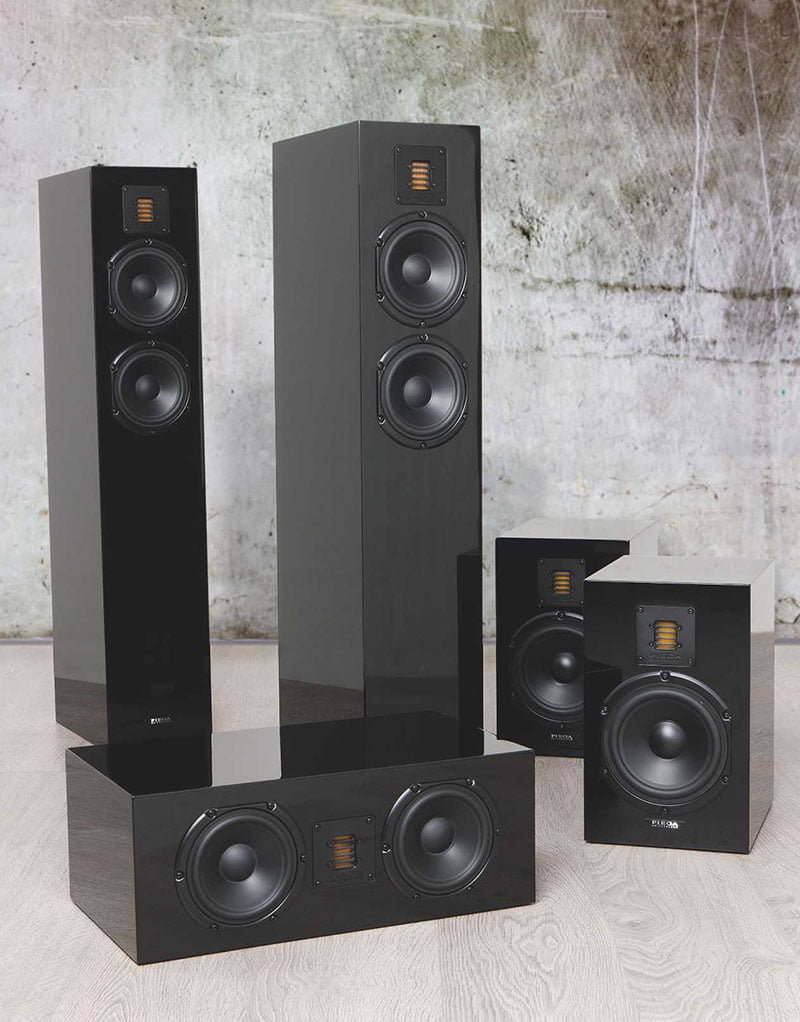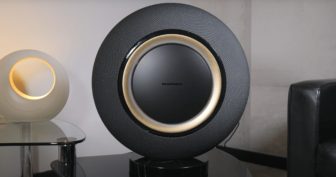Do your speakers sound a little constrained? Piega might have just the thing for you, says Ed Selley
Swiss speaker spacecraft
AV INFO
PRODUCT: 5.0-channel floorstanding speaker set
POSITION: Toward the low-end of Piega’s lineup
PEERS: Spendor S3/5R2 CR3 system; DALI Opticon 5.1
Speaker brands comfortably outnumber electronic ones in the multichannel world. At any given price point, you’ll have more speaker options than you will amplifier choices. As a result, the market is crowded and new arrivals can’t simply rely on looking smart. Handy for Piega, then, that behind the reasonably attractive cabinets of this 5.0 system, there’s a lot going on.
Contents

Most notable is the tweeter that’s common to all units. It might look a like a ribbon tweeter, but is something rather different. Piega is one of only a few brands – and one of the most consumer-friendly when it comes to pricing – to dress its speakers with an Air Motion Transformer (AMT). This is a folded diaphragm that effectively works like a shrunken high-frequency accordion. A back and forth motion creates treble energy but, because the unit itself is very large – effectively equivalent to a driver several inches across – the radiating effect is correspondingly greater. It’s a treble unit that – on paper at least – looks perfect for the job of creating a wide, immersive soundstage, and claims a high-frequency extension all the way to 40kHz.
As well as the AMT, the three models that make up this set – the Classic 5.0 floorstanders, Classic 3.0 standmounts and Center Classic Large – feature one or more midbass drivers that use a system that Piega terms ‘MDS’ (Maximum Displacement Suspension), which is designed to help them deliver a long throw without distortion or cone breakup. Unusually, the centre and fronts make use of a 5in driver while the standmounts feature a larger 6.5in unit. This deviates from the absolute ideal of having the same driver in every corner of the room, but as the materials and technologies are the same, I’m not too concerned.
The Classic enclosures are traditional in design, certainly by the standards of Piega. They’re made from MDF sections and are flat-sided. Further up the Classic range, the cabinets switch to curved edges, which is something of a Piega trademark, and if you really open your wallet up, the Swiss company does a mean line in aluminium enclosures. This might mean that the Classics don’t sound terribly exciting design-wise, but the cabinets themselves are well finished and extremely solid to the touch. The black finish is standard (white is also available) but for a price premium you can also get them in Macassar Ebony, which looks rather tasty.
Like a number of packages from smaller audio companies, this array didn’t come with a subwoofer. You can look at offerings from the usual suspects to partner them. In terms of matching with electronics, the Piegas should be pretty straightforward. Providing that your receiver can handle a four-ohm load – and most AVRs ought to – the Classics have the advantage of being impressively sensitive. I was able to test them with the Emotiva A-700 power amplifier [see HCC #278] which was still present in my system, and this had no trouble at all with them. Installation is easy enough, too. There are optional plinths for the floorstanders (not photographed) that are simple to attach and the terminals are a cinch to connect cables to.
Just a little nudge…
Once up and running, it is the sensitivity of the Piegas that is most immediately apparent. The speakers need a lower posted volume level to hit key test tone increments than almost any comparably sized speaker package I’ve tested, and this is matched by a very even performance from low through to neighbour-aggravating levels. Listen a bit longer, though, and the speakers reveal other distinctive and positive qualities.
Even though there are two different midbass drivers at work in the array, subjectively everything sounds seamless. The fight between Peter Quill and Ego at the end of Guardians of the Galaxy Vol 2 (Blu-ray) is truly involving, with a smooth and controlled transition from speaker to speaker and plenty of impact available from each cabinet, reducing the demands made on your subwoofer.
There’s plenty of fine detail, too. The realism quotient in a scene where a man fights a planet is hard to quantify, but everything sounds convincing, with depth to the cracking,
1. AMT tweeters are used across the Piega Classic range
crumbling Foley work. And there’s a solid sense of energy. The Classic speakers might be civilised compared to something like Neat’s irrepressible IOTA five-channel pack [see HCC #272] but they are still effortlessly capable of loading a room.
The party piece of this Piega Classic 5.0 system really only makes itself felt when you switch to something less in-yer-face. The AMT tweeters are absolutely outstanding
There is a lack of boxiness here that at times means you completely dial the Piega speakers out of the equation
with dialogue, and give the soundfield a realism and tangibility that is rarely heard at the price. The first meeting between Deckard and Tyrell in Blade Runner (Blu-ray) is stunningly real; the fractional echo to their voices and every change to their intonation is captured perfectly.
More than anything else, you get a complete sense of the scope and scale of any space that the Classics are asked to reproduce. Their extremely wide dispersion is a factor in this; you’ll feel surrounded by cavernous environments onscreen.
Proof in the pudding
As mentioned earlier, the performance here is linear.
The Piegas’ headline tricks – clarity, detail and soundstage depth/width – are just as useful with The Great British Bake Off as they are for movie night, and they remain in evidence when volume levels are kept low. The Classic Center Large is the unsung hero here. It has no trouble unpicking the congested and recessed centre channel that can accompany a number of TV multi channel broadcasts, ensuring that you don’t miss a single word of dramatic dialogue or groan-worthy pastry pun. If you use your speakers all the time, these are a good fit.
Unsurprisingly, considering the brand’s audiophile ethos, this package cuts the mustard when asked to go hi-fi. Yes, in the same way that the Classics can sometimes sound restrained with ballistic action sequences, they can also lack the last ounce of excitement and dynamism with music, but the trade-off is an exceptional refinement in their mids and highs and a soundstage that can draw you into a track. A blast of the new Stars album (There is No Love in Fluorescent Light), from Tidal via a Yamaha WX-AD10, generates a wonderfully involving and passionate performance, with resonant piano lines and tactile vocals.
It’s this nuance and expression (and sense of space) that marks the Piegas out from their similarly-priced rivals. There is a lack of boxiness that at times means you completely dial them out of the equation, and get that one stage closer to what you’re listening to.
Classic by name, classic by nature?
Some people will want a little more attack from their speakers for both movies and music, especially at this price. Others will crave an overall design that draws more attention to itself. And some won’t appreciate having to shop around separately for a subwoofer (I used my standard BK Electronics 12-incher). These are all factors to consider.
On the other hand, Piega’s Classics have a performance that startles at times, and, combined with their benign sensitivity and superb build quality, means that for some buyers, these could be too good to miss
VERDICT
SPECIFICATIONS
Classic 5.0
DRIVE UNITS: 1 x AMT tweeter; 2 x 5in ‘MDS’ midbass drivers ENCLOSURE: Ported FREQUENCY RESPONSE (CLAIMED): 36 Hz-40 kHz SENSITIVITY (CLAIMED): 91dB POWER HANDLING (CLAIMED): 150W DIMENSIONS: 180(w) x 930(h) x 280(d)mm WEIGHT: 20kg
Classic 3.0
DRIVE UNITS: 1 x AMT tweeter; 1 x 6.5in ‘MDS’ midbass drivers ENCLOSURE: Ported FREQUENCY RESPONSE (CLAIMED): 38 Hz-40 kHz SENSITIVITY (CLAIMED): 89dB POWER HANDLING (CLAIMED): 150W DIMENSIONS: 210(w) x 340(h) x 280(d)mm WEIGHT: 7.7kg
Classic Center Large
DRIVE UNITS: 1 x AMT tweeter; 2 x 5in ‘MDS’ midbass drivers ENCLOSURE: Sealed FREQUENCY RESPONSE (CLAIMED): 50Hz-40kHz SENSITIVITY (CLAIMED): 90dB POWER HANDLING (CLAIMED): 150W DIMENSIONS: 480(w) x 180(h) x 260(d)mm WEIGHT: 11kg
PARTNER WITH
YAMAHA RX-A3070: Rated for four-ohm as well as eight-ohm loads, Yamaha’s flagship nine-channel AVR follows the brand’s Aventage construction ethos, and should have the power on tap to drive the Piega speakers with ease.
2. The Classic 5.0s and 3.0s are rear-ported; the Center Large isn’t






